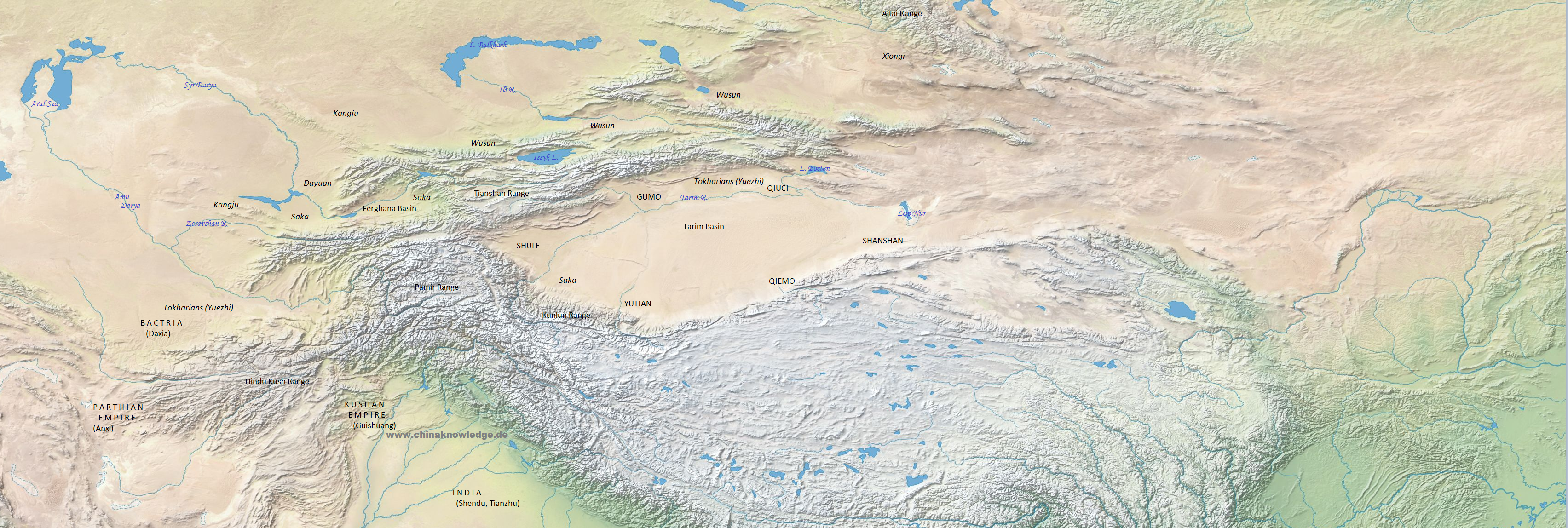Dayuan 大宛 (not Dawan!) was a state located west of the Pamir Range, covering the middle and lower course of the River Syr Darya and the Ferghana Basin. It was founded by the Indo-European people of the Sakas (Chinese name Sai 塞). Alexander the Great (r. 336-323) founded in this region the city of Alexandria Eschate that was renamed Antiochia by the Hellenic rulers of the Seleucid kingdom that ruled over Persia after the death of Alexander.
It seems that the armies of the Hellenic rulers did not invade the territory of the people of Dayuan. This only happened when the armies of the kingdom of Bactria (by the Chinese called Daxia 大夏) marched in all directions around 200 BCE.
 |
Based on Tan Qixiang 譚其驤, ed. (1995), Zhongguo lishi ditu ji 中國歷史地圖集, Vol. 2, Qin, Xihan, Donghan shiqi 秦西漢東漢時期 (Beijing: Zhongguo ditu chubanshe, 1996). Tribes and peoples in italics, states in normal letters. |
During the Former Han period 前漢 (206 BCE-8 CE) the first Chinese traveller reached the region of Dayuan, namely Zhang Qian 張騫 who had been sent out to reconnoiter good horse breeders and eventual allies against the steppe federation of the Xiongnu 匈奴. He reported that there were more than 70 cities in the country of the Dayuan, with a population of several 10,000 persons. They lived of pastoral nomadism, but some of them also worked the fields and produced grains and various field fruits. Yet they were especially famous for their so-called "blood-sweating" horses (hanxuema 汗血馬).
The people of Dayuan highly welcomed Zhang Jian when they saw the high potential of trade with China across the Pamir range. In 104 Emperor Wu 漢武帝 (r. 141-87 BCE) sent out an envoy with gold and silk to purchase horses in Dayuan, but the business was not concluded and the envoys were killed. Enraged, Emperor Wu sent out general Li Guangli 李廣利 to submit the Dayuan. His first military campaign was not successful as he was defeated in the battle of Yucheng 郁成.
Li returned in 101 BCE, with a better logistics apparatus, and was able to kill King Wugua 毋寡. He enthroned a certain Meicai 昧蔡 as the new king of Dayuan and so ensured a stable and peaceful relationship between the Han empire and the famous horse-breeders in the west. The capital of the kingdom of Dayuan was Guishan 貴山 (modern Kazan or Khojend, both located on the banks of River Syr Darya), another important city was Nishi 貳師 (probably modern Uratepe near Bukhara, Uzbekistan). The kingdom of Dayuan ceased to exist in the early 4th century CE.